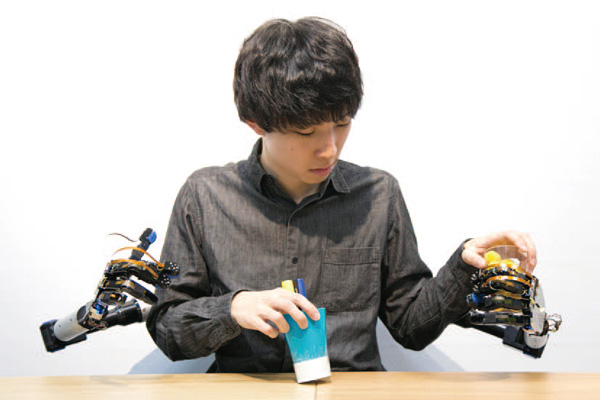- HOME
- Research
- Research Category
- Information Somatics Inami - Monnai Laboratory
Information Somatics
Inami - Monnai Laboratory
Understanding and designing the body schema based on human factors and physiology
We are conducting research on "Information Somatics," which explores the mechanisms of the body as a physical information system based on physiological, cognitive, and physical findings. It aims to enhance the innate human sensory functions, motor functions, emotional functions, and intellectual processing abilities through measurement, communication, and control technology.
Extended Body
Research on technologies that extend human input/output by integrating biometric information such as gaze, facial expressions, and heart rate, with sensory and perceptual measurement technologies such as motion prediction and intention, and intervention technologies like robot control or electrical muscle stimulation. This involves engineering research and development aimed at enhancing human capabilities and acquiring new bodily perceptions by appropriately sensing the user's intent and feeding back information about the task object to the user's body.
Extended Communication
The human body and mind are inseparably related, and subjective experiences such as perception and emotions are constituted through the mediation of one's own and others' bodies. In a system that includes both self and others, this research aims to transform subjective experiences by controlling the flow of physical and cognitive information using Virtual Reality (VR), augmented reality, wearable technology, wireless technology, robotic technology, and telexistence. The goal is to socially implement support for communication among users with different attributes and preferences, aiming for the realization of super-aged societies and smart cities where diverse people thrive.
Wireless Interaction
In measurement and communication, electromagnetic waves are used in the air (outside the body), while ultrasound is used in water (inside the body), resulting in a separation between the two physical layers. To bridge this gap, we are developing novel wireless technologies. Specifically, we are working on non-contact ultrasound generation inside the body via terahertz wave irradiation and beam-tracking technology enabling terabit-class communication with moving individuals and devices. These advancements aim to revolutionize biological measurement and human-computer interaction. Furthermore, we are expanding these technologies for non-destructive testing applications, ranging from modern industrial products to historical artifacts dating back a thousand years.

MetaLimbs: a Jizai Technology for Acquiring a Body Schema

Non-contact stethoscope that monitors human heartbeat through the clothes using terahertz waves.

Motor interventions to enhance users' physical ability
Our laboratory uses the domain name @star.rcast. This domain name is derived from "Science and Technology of Artificial Reality," originally coined and utilized by Professor Emeritus Susumu Tachi since the 1990s. Remarkably, the high flexibility inherent in the four-letter acronym "STAR" was intentionally embedded from the very beginning. Currently, our lab places Somatics, aiming at mind-body integration, at its core. We also leverage technologies such as Terahertz waves and Artificial intelligence to extend human Recognition capabilities and facilitate functional Rehabilitation.
Tasks traditionally performed by humans operating keyboards and mice are now increasingly executed by AI. Observing these developments leads us to reflect upon what it means to be human, vividly recalling Kenji Miyazawa's words: "The phenomenon called 'I' is a single blue illumination of a presupposed organic alternating current lamp." Within our finite lifespan, questions about how technology can best enhance cognition and support physiological and social activities will only grow in importance. At our laboratory, we enjoy engaging daily with these fundamental questions through ongoing interactions and exchanges with diverse individuals.(Monnai)
Member

-
- Professor
Masahiko INAMI
Research Area: Augmented human, Virtual reality, Entertainment computing - Professor

-
- Associate Professor
Yasuaki MONNAI
Research Area: Terahertz engineering, Human interface - Associate Professor
Laboratory Homepage
Tags

